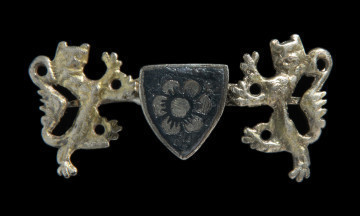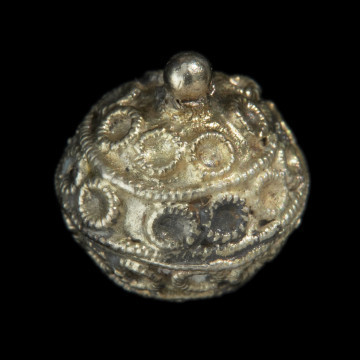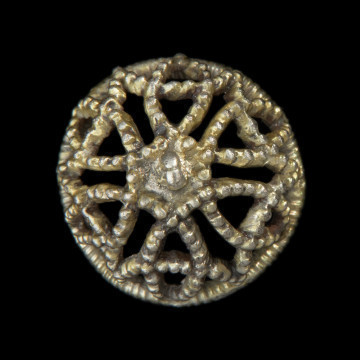
Hook
przełom XIV i XV wieku
National Museum in Szczecin
Part of the collection: Szczecin treasure from Podzamcze
In the 14th -15th century, characteristic costume ornaments were silver clasps, which consisted of a spike and a decorative frame, often in the shape of a circle. Circular clasps were sometimes decorated with artistic ornaments in the form of floral motif, Latin inscriptions or openwork patterns. An unusual example of a silver circular clasp is a piece with the inscription AVE MARIA, with a frame made of intertwined hands. Intertwined hands symbolised betrothal or marriage. Therefore, the clasp is referred to as a wedding clasp of the Handtruwebrazen type. Hands intertwined in a hug were also a symbol of loyalty, trust and friendship. Small round clasps with a hole in the frame for setting a pike were known in Europe from the 2nd half of the 12th century, while AVE MARIA forms with inscription or motif of intertwined hands were used only between the 12th and 14th centuries. The clasp was found among other silver and gold ornaments hidden with Pomeranian coins in a metal container under the floor of a tenement house in Szczecin's Podzamcze district. Precious metals, such as silver and gold, were intended as ornaments for the upper classes, while the less wealthy had to make do with ornaments made of tin, copper or brass.
Małgorzata Peszko
Author / creator
Dimensions
cały obiekt: height: 0,48 cm, diameter: 3,4 cm
Object type
costium adorment, adornment
Creation time / dating
Creation / finding place
Identification number
Location / status

przełom XIV i XV wieku
National Museum in Szczecin

przełom XIV i XV wieku
National Museum in Szczecin

przełom XIV i XV wieku
National Museum in Szczecin
DISCOVER this TOPIC
National Museum in Szczecin
DISCOVER this PATH
Educational path